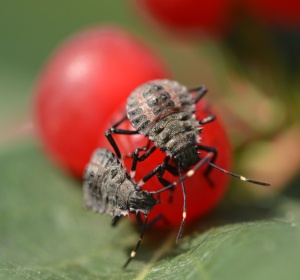Hannah Fraser, Entomology-Horticulture Program Lead, OMAFRA
The brown marmorated stink bug (BMSB) is a relatively new pest, and we are still learning about its biology and how to control it. Thresholds and management programs are still being developed in the US, in areas where BMSB is abundant¹. Scouting is always important, on both the crop and on nearby landscape hosts. Buckthorn, Catalpa, pin cherry, honeysuckle, lilac, Manitoba maple, black walnut Tree of Heaven are wild hosts that support development, but there are many others (Figure 1). BMSB females will often lay their eggs on hosts in unmanaged areas, allowing their numbers to build up (undetected). What triggers movement through the season from wild hosts to crops is still being studied, but it is most likely a function of population density, humidity levels, changing resource quality and/or nutritional needs of the bugs.
BMSB adults and nymphs are quite mobile (not to mention great at hiding), and may be difficult to spot in the field, especially when numbers are low (Figure 2). Low numbers of BMSB observed when scouting may still equate to economic injury as populations increase, especially during very dry years. Make sure to look for signs of stink bug injury, especially along crop borders near woodlots, hedgerows, the Escarpment, etc. Early injury in tree fruit looks like water spots or small areas of bleeding, becoming depressed or sunken as fruit develops (‘catfacing’). In apples, injury may take 2-3 weeks before it is obvious. Injury to tomatoes or peppers appears as discoloured spots (‘halos’), with light-coloured spongy tissues under the skin. Because stink bugs are often present in numbers, and because they will make multiple punctures with their mouthparts, a single fruit or vegetable may have many points of injury. One BMSB can injury many fruits / vegetables over the course of its development. More descriptions and pictures are available on our webpages at www.ontario.ca/stinkbug.

Figure 1—BMSB nymphs feeding on honeysuckle.

Figure 2—BMSB adults on Manitoba maple.
Pheromone traps are being recommended for use as early detection tools, to trigger intensive scouting in crops and to time insecticide applications. There are several models available, but almost all of them include some form of pyramid to direct the movement of the bugs and a collection container to trap and hold them. Traps are loaded with 1) a pheromone for BMSB, 2) a synergist (‘MDT’) to enhance performance through the season, and 3) an insecticide strip to kill bugs and help prevent them from escaping (Figure 3). There are various suppliers/ types of pheromone lures; each has different performance characteristics and longevity. Traps should be placed in the field from May through harvest.